![]()
![]()
![]()
Use LEFT and RIGHT arrow keys to navigate between flashcards;
Use UP and DOWN arrow keys to flip the card;
H to show hint;
A reads text to speech;
51 Cards in this Set
- Front
- Back
|
Which distance is larger?
Choose one answer. a. 1 AU b. 1 light year |
b. 1 light year: an AU is the distance between the Erath and the sun, and light takes less than a year to get from the sun to us (abuot 8 seconds)
|
|
|
Which of the following correctly describes the local celestial meridian in your sky?
|
A half-circle extending from your horizon due north, through your zenith, to your horizon due south.
|
|
|
Which of the following statements about the celestial sphere is NOT true?
Choose one answer. a. The celestial sphere is just another name for our universe. b. The celestial sphere does not exist physically. c. When we look in the sky, the stars all appear to be located on the celestial sphere. d. In the celestial sphere model, Earth is placed at the center of the celestial sphere. |
a. The celestial sphere is just another name for our universe.
THIS IS FALSE |
|
|
Altair has a RA of 19.8 hours and a Dec of +9 degrees. Reno has a latitude of 39.5 degrees North and a longitude of 120 degrees West. As seen from Reno, what is the azimuth (in degrees) of Altair when it reaches its maximum altitude?
|
180 deg
|
|
|
We describe a location on the Earth's surface by stating its
|
latitude and longitude
|
|
|
About how many stars are visible to the naked eye on a clear, dark night away from city lights?
|
A couple thousand
|
|
|
What is the global positioning system (GPS)?
|
A set of satellites orbiting the Earth, from which it is possible to compute precise locations on the ground.
|
|
|
where are points of declination and right ascension located?
|
on the celestial sphere
|
|
|
what is declination
|
declination tells us the angular distance of an object from the celestial equator
|
|
|
what is right ascension? how is it determined?
|
right ascension tells us how far around the celestial sphere an object is located counterclockwise from the vernal equinox
|
|
|
If you were standing on Earth's equator, where would you look to see the North Celestial Pole?
|
Directly on your horizon due north.
|
|
|
T/F: With more advanced technology, we may one day be able to land on the celestial sphere.
|
False: the celestial sphere does not exist in reality, it is only used as a reference
|
|
|
Universal time, or UT, is
|
the mean solar time in Greenwich, England.
|
|
|
The point directly over your head is called
|
the zenith
|
|
|
T/F: Although all the stars we currently know about appear to rise in the eastern part of the sky and appear to set in the western part of the sky, we might someday discover a star that will appear to rise in the western part of the sky and set in the eastern part of the sky.
|
False: the stars appear to be moving because the Earth is spinning, not because they are actually moving. if the Earth is spinning in one direction, no stars can appear to move in the opposite direction of other stars
|
|
|
What is the celestial sphere?
|
The celestial sphere is a representation of how the sky looks as seen from Earth.
|
|
|
Suppose you live at latitude 40 degrees N. Which of the following describes the path of the celestial equator through your sky?
|
It goes from due east on your horizon, to an altitude of 50 degrees in the south, to due west on your horizon
|
|
|
Suppose you are facing north, and you see the Big Dipper close to your northern horizon, with Polaris (and the Little Dipper) above it. Where will you see the Big Dipper in six hours?
|
To the right of Polaris.
|
|
|
Altair has a RA of 19.8 hours and a Dec of +9 degrees. Reno has a latitude of 39.5 degrees North and a longitude of 120 degrees West. As seen from Reno, what is the maximum altitude (in degrees) above the horizon that Altair will reach?
|
59.5
|
|
|
Stars that are visible in the sky on any clear night of the year, at any time of the night, are called
|
circumpolar
|
|
|
Consider the following right ascension and declination data for four stars. Spica has RA = 13.5 hours and Dec = -11.3 degrees. Deneb has RA = 20.6 hours and Dec = +45 degrees. Sirius has RA = 6.75 hours and Dec = -16.6 degrees. Alpha Centauri has RA = 14.6 hours and Dec = -60.75 degrees. Which of these stars lies closest to the north celestial pole on the celestial sphere?
|
Deneb
|
|
|
How many arcseconds are in 1 degree?
|
3,600
(60 * 60) |
|
|
How many arcseconds are in 1 degree?
|
3,600
(60 * 60) |
|
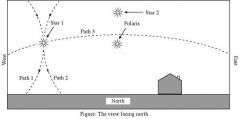
The figure shows the view due North. In this figure, which path correctly shows how Star 1 moves throughout the night?
|
Path 2
|
|
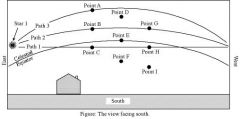
The figure shows the view due South. Which of the following points has the largest right ascension?
B,D,G, or not enogh info? |
Not enough information to tell.
|
|
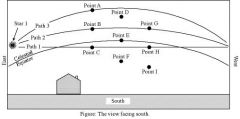
The figure shows the view due South. Which point is at the greatest declination?
A, D, G, or not enough info? |
Point A
|
|
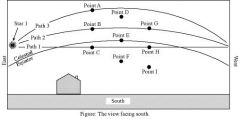
The figure shows the view due South. Which point is at the largest Azimuth?
B, D, G, or not enough info? |
Point G
|
|
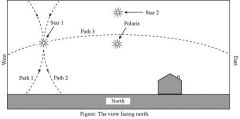
The figure shows the view due North. As seen from this location, is Star 2 circumpolar?
|
yes, star 2 is circumpolar
|
|
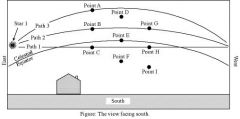
The figure shows the view due South. Which point has the greatest altitude?
D, E, F, or not enough info? |
Point D
|
|
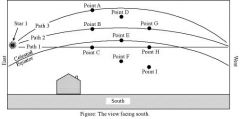
The figure shows the view due South. Which path correctly shows how Star 1 moves throughout the night?
|
Path 2
|
|
|
When traveling north from the United States into Canada, you'll see the North Star (Polaris) getting
|
higher in the sky.
|
|
|
Galileo challenged the idea that objects in the heavens were perfect by
|
observing sunspots on the Sun and mountains on the Moon
|
|
|
Consider a comet that approaches the Sun along a parabolic trajectory. After passing the Sun and moving away again, what factor most effects how long it will take the comet to return?
|
The comet never returns.
|
|
|
Which of the following was NOT observed by Galileo?
Choose one answer. a. phases of Venus. b. mountains and valleys on the Moon. c. four moons orbiting Jupiter. d. stellar parallax |
d. stellar parallax was NOT observed by Galileo
|
|
|
How did the Ptolemaic model explain the apparent retrograde motion of the planets?
|
It held that the planets moved along small circles that moved on larger circles around the Earth, and that the combined motion sometimes resulted in backward motion
|
|
|
Imagine Earth were twice as massive as it actually is. If this heavier Earth continued to orbit the Sun at a distance of 1 AU, how long would one complete orbit take?
|
1 year: period of orbit is determined by distance from the orbiting object, not mass.
|
|
|
While the Moon orbits Earth, is the Moon accelerating?
|
Yes, because it is continuously changing direction in space
|
|
|
Imagine you are bouncing on a trampoline. While you are in the air, Earth is pulling on you. You pull back on Earth with a force that is
|
equal to the pull exerted by Earth on you.
|
|
|
Suppose you lived on the Moon. how would your mass and weight compare to when you were on Earth?
|
Your weight would be less than your weight on Earth, but your mass would be the same as it is on Earth.
|
|
|
Ptolemy was important in the history of astronomy because he
|
developed a model of the solar system that made sufficiently accurate predictions of planetary positions to remain in use for many centuries.
|
|
|
Imagine view Mars from your backyard over the span of a few nights. If you see that Mars is undergoing "direct motion", that means you must be seeing Mars move slowly in what direction?
|
eastward across the sky from one night to the next.
|
|
|
While the Space Shuttle is in orbit about Earth, how many forces are acting on the Space Shuttle?
|
One force pulling towards Earth.
|
|
|
Which of the following represents a case in which you are NOT accelerating?
Choose one answer. a. Slamming on the brakes to come to a stop at a stop sign. b. Going from 0 to 60 miles per hour in 10 seconds. c. Driving in a straight line at 60 miles per hour. d. Driving 60 miles per hour around a curve. |
c. Driving in a straight line at 60 miles per hour is NOT accelerating.
|
|
|
The shape of Earth's orbit about the Sun is
|
elliptical with the Sun at the one focus of the ellipse.
|
|
|
According to the universal law of gravitation, if you triple the distance between two objects, then the gravitational force between them will
|
decrease by a factor of 9.
|
|
|
The great contribution of Tycho Brahe was to
|
observe planetary positions with sufficient accuracy so that Kepler could later use the data to discover the laws of planetary motion
|
|
|
According to Ptolemy's Geocentric model, when would Jupiter be closest to Earth?
|
During retrograde motion.
|
|
|
The difference between speed and velocity is that ...
|
velocity also includes a direction.
|
|
|
T/F: Is an apple falling to the ground accelerating?
|
True: the acceleration of gravity is 9m/s^2
|
|
|
Galileo's observation that Jupiter has its own moons contradicts the Geocentric model by showing
|
there are celestial objects that do not orbit Earth.
|
|
|
The great contribution of Nicholas Copernicus was to
|
create a detailed model of our solar system with the Sun rather than Earth at the center
|

